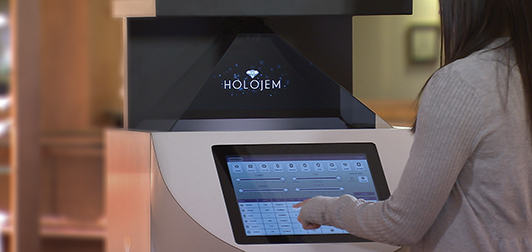 |
| Holographic display in Holojem kiosk. Photo credit: Jewelers Mutual |
Imagine customizing a piece of diamond jewelry and with the tap of a finger, projecting a 3-D image suspended in the air that can be rotated, expanded and inspected at will with the wave of hand. Augmented Reality (AR) technology, which modifies how people view the real-world environment through computer-generated input, has come a long way since the 1990s. One company, Jewelers Mutual Insurance Company (JM), is embracing AR in the form of holographic technology – Holojem — to enhance the consumer’s shopping experience.
• A standing kiosk that contains a touchscreen that customers can use to browse a jeweler’s catalog. Selected jewelry then appears on a pyramidal display as a hologram. Hand movements and motions are detected by sensors to rotate, enlarge and shrink a real-time rendered image of the jewelry. Retailers can also upload educational or other content to display on the screen. Kiosks can be customized for branding and can be plugged into an outlet anywhere.
• The portable “projector pyramid,” which can be folded flat. This Mylar plastic peripheral allows customers to display holograms of jewelry via the Holojem app on their phones. The image is projected onto the peripheral, which stands about three inches tall and is placed on the phone screen.Users can also share their browsing experience on social media platforms with the integrated “share” features in both the kiosks and on the mobile app.
YOU MUST HAVE JAVASCRIPT ENABLED TO VIEW THE SLIDESHOW
Article from the Rapaport Magazine - April 2017. To subscribe click here.